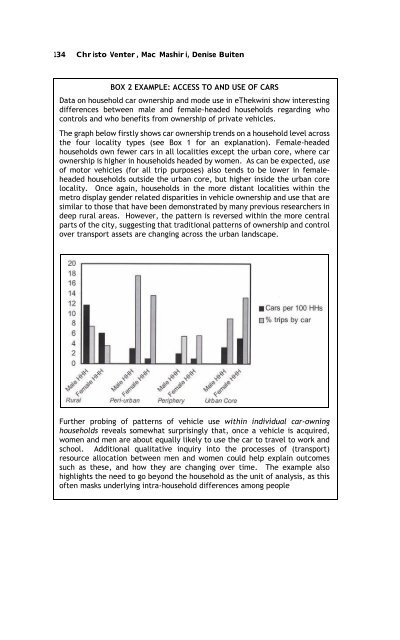Sex, Gender, Becoming - PULP
Sex, Gender, Becoming - PULP
Sex, Gender, Becoming - PULP
You also want an ePaper? Increase the reach of your titles
YUMPU automatically turns print PDFs into web optimized ePapers that Google loves.
134 Christo Venter, Mac Mashiri, Denise Buiten<br />
BOX 2 EXAMPLE: ACCESS TO AND USE OF CARS<br />
Data on household car ownership and mode use in eThekwini show interesting<br />
differences between male and female-headed households regarding who<br />
controls and who benefits from ownership of private vehicles.<br />
The graph below firstly shows car ownership trends on a household level across<br />
the four locality types (see Box 1 for an explanation). Female-headed<br />
households own fewer cars in all localities except the urban core, where car<br />
ownership is higher in households headed by women. As can be expected, use<br />
of motor vehicles (for all trip purposes) also tends to be lower in femaleheaded<br />
households outside the urban core, but higher inside the urban core<br />
locality. Once again, households in the more distant localities within the<br />
metro display gender related disparities in vehicle ownership and use that are<br />
similar to those that have been demonstrated by many previous researchers in<br />
deep rural areas. However, the pattern is reversed within the more central<br />
parts of the city, suggesting that traditional patterns of ownership and control<br />
over transport assets are changing across the urban landscape.<br />
Further probing of patterns of vehicle use within individual car-owning<br />
households reveals somewhat surprisingly that, once a vehicle is acquired,<br />
women and men are about equally likely to use the car to travel to work and<br />
school. Additional qualitative inquiry into the processes of (transport)<br />
resource allocation between men and women could help explain outcomes<br />
such as these, and how they are changing over time. The example also<br />
highlights the need to go beyond the household as the unit of analysis, as this<br />
often masks underlying intra-household differences among people
















